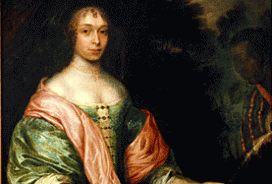In Greater Manchester
- How money from slavery made Greater Manchester
- The importance of cotton in north west England
- The Lancashire cotton famine
- Smoking, drinking and the British sweet tooth
- Black presence in Britain and north west England
- Resistance and campaigns for abolition
- The bicentenary of British abolition
Global

A black servant to the Butterworths
What evidence is there of a black presence in Britain and north west England?
Millions of African men, women and children were forcibly taken from Africa by Europeans to the Americas, and a few came to Britain, some willingly and others by force. It is thought that there were 10,000 black people in Britain in the late 1700s.
In the 1600s and 1700s it was fashionable among the British aristocracy to have black servants to indicate wealth, status and refinement. A number of portraits in Greater Manchester show wealthy families with their elaborately attired black servants.
The Percival family of Royton Hall near Oldham had a black servant named Juba Thomas. The parish registers show he was christened in 1761 and married Betty Mellor in March 1765. Juba states his profession as a ‘waiting man’ in the baptismal records of his four children. Juba Howard (who died 1808) also lived at Royton Hall.
A number of other West Indian or ‘Negro’ entries can be found from the parish registers on the Manchester City Council’s archive and local studies website www.manchester.gov.uk/libraries/arls. For example:
Cross Street Presbyterian Chapel, Manchester, baptism 21 December 1771. ‘Immy and Fanny, two West Indian girls, one about 15, the other about 13 years of age, natural children of Mr. Campbell of Scotland’.
Manchester Cathedral, burial 20 May 1757, ‘Phillip a negro from Mr John Mosse’.
The legal status of black servants began to change after the Somerset case of 1772 when James Somerset won a legal case against his owner who was attempting to force him to return to the West Indies. This began the movement to improve the rights of black enslaved Africans in Britain and the wider campaign against slavery.
There was a significant black presence in the north west of England from the late 1700s. In 1787 Thomas Clarkson noted at a speech in Manchester that:
'I was surprised also to find a great crowd of black people standing round the pulpit. There might be forty or fifty of them.'
In the 1800s many abolitionists who were former enslaved Africans such as William Wells Brown, Henry Box Brown, Frederick Douglass and James Watkins also visited the north west of England to campaign against slavery in America.
The museum collections in the north west hold a range of objects showing black people. As well as the imagery of black servants in paintings there are illustrations on the front of ex-slave narratives such as James Watkins, and items such as coins, pipes and advertising material also showing black people.